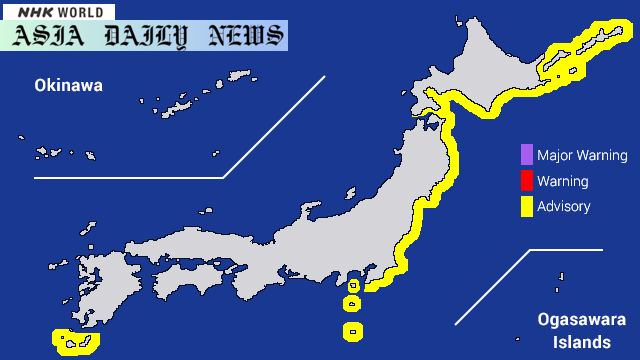Tsunami warnings persist along Japanese coasts from Hokkaido to Chiba, including Izu Islands and parts of Kagoshima.
Key Point 1: Tsunami advisories partially lifted in Japan.
Key Point 2: Alerts remain for areas like Hokkaido, Chiba, and Izu Islands.
Key Point 3: Residents in affected regions are urged to remain cautious.

Partial Lifting of Tsunami Advisories in Japan
Following recent oceanic activity, Japan has decided to partially lift tsunami advisories across some regions. This development marks a shift in the ongoing situation that has been monitored closely over recent days. However, authorities continue to enforce cautious measures in areas still under advisory. The impacted regions include coastal areas stretching from Hokkaido to Chiba, alongside the Izu Islands and parts of Kagoshima. These warnings are primarily driven by residual oceanic shifts resulting from seismic activity in the Pacific region.
Why the Warnings Remain in Specific Areas
Despite lifting advisories in some parts, experts caution against complacency in the locations where warnings remain active. Tsunami risks, even if diminished, require vigilance and preparedness to minimize potential harm. Precise measures like evacuation plans and constant updates from meteorological agencies ensure the safety of residents in zones under continued watch. Monitoring equipment positioned along coastal borders has been yielding crucial insights, helping officials prioritize affected regions. These technological advances underpin Japan’s robust disaster-response system, reducing fatalities and improving overall readiness.
Steps Taken by Authorities and Communities
The Japanese government, in collaboration with local bodies and specialized agencies, has been issuing real-time communication updates to citizens. Emergency response systems are active across the affected regions, with teams ready to deploy further aid resources. Meanwhile, local communities are practicing the recommended guidelines for coastal emergencies, enhancing public confidence. Special advisories for fisheries, shipping operations, and port management are also being disseminated to reduce risks to maritime operations.
Preparedness and Future Implications
Japan’s preparedness against natural disasters is a commendable model for other nations prone to similar threats. The decision to lift tsunami warnings in some areas symbolizes a calculated optimism anchored on scientific data. However, these events underscore the ongoing importance of robust monitoring systems, efficient communication networks, and safety drills across vulnerable populations. With climate change influencing patterns of natural disasters worldwide, Japan’s continued investment in disaster infrastructure and public education provides valuable lessons about long-term resilience strategies.



Commentary
Reflections on Tsunami Advisories
The situation regarding tsunami advisories in Japan offers an important window into the complexities of disaster management. The partial lifting of these warnings is undoubtedly a positive step, signaling effective risk management and a reduction in immediate threats. However, the fact that advisories persist in critical coastal areas from Hokkaido to Kagoshima reminds us of the unpredictable nature of natural disasters. Communities living in those regions continue to face uncertainty, requiring them to remain vigilant and prepared for any sudden changes.
Lessons from Japan’s Proactive Response
One of the most commendable aspects of Japan’s response is its reliance on data-driven strategies and decision-making. From advanced early-warning systems to widespread public education, the nation has showcased its commitment to safeguarding lives. This situation, however, also highlights the strain natural disasters place on affected communities. Coordinating between government bodies and local municipalities is no easy task, but Japan’s proactive approach should serve as an example to other nations striving for disaster resilience.
The Human Factor
Beyond infrastructure and technology, the human resilience shown by Japan’s residents is equally inspiring. Stories of communities coming together in the face of adversity reinforce the importance of solidarity during crises. These narratives highlight the strength and adaptability people demonstrate, often emerging with renewed determination to rebuild after setbacks. For a world increasingly grappling with natural disasters, these events emphasize the need for collaboration, innovation, and community-focused solutions.